Choosing Australia’s top travel experiences is not easy, and while many usual suspects appear in Lonely Planet’s list, some may even surprise locals
At 7.6m sq km, spanning eight climate and three time zones, Australia is a big country. So where do you start?
In making their new book, Lonely Planet’s Ultimate Australia Travel List, the travel guide publisher began by compiling every highlight in their existing books. “We then asked our writers, editors, designers and cartographers in Australia to reveal their favourite spots and experiences,” they say. From there, they solicited votes from a panel of travel experts and members of their community.
The result, “with hundreds of votes cast and a bit of mathematical alchemy, as well as a keen eye on sustainability practices”, is a new book of 500 experiences. They also ended up with “one very clear winner”.
Here is that winner, along with the rest of the book’s Top 20 experiences.
1. Fall silent before the majesty and gravitas of Uluru
Northern Territory/Anangu Country
The landscape of Uluru changes dramatically with the shifting light and seasons. In the afternoon, Uluru appears as an ochre-brown colour, scored and pitted by dark shadows.
As the sun sets, it illuminates the rock in burnished orange, then a series of deeper and darker reds before it fades into charcoal. A performance in reverse, with marginally fewer spectators, is given at dawn.
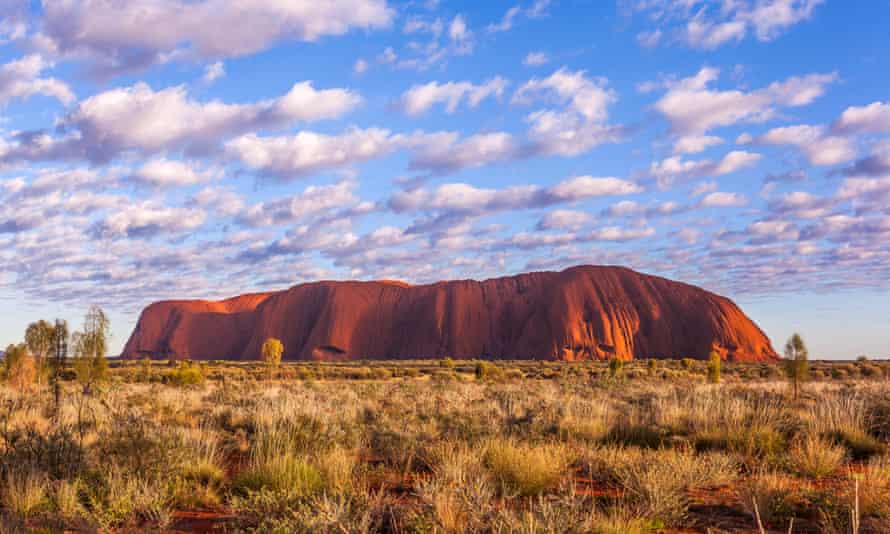
Uluru at sunrise. Photograph: Maurizio De Mattei/Shutterstock
Uluru is a beautiful, charismatic place. Its dimensions are one thing: it is 3.6km long and rises 348m from the surrounding sands (867m above sea level). If that’s not sufficiently impressive, remember this: two-thirds of the rock lies beneath the sand.
Uluru is a monolith textured with layers of profound spirituality and timeless beauty, the epitome of desert stillness and, in the plays of light and shadow that dance across its surface, one of the richest shows in nature. The sunset viewing areas are once-in-a-lifetime experiences understanding its singular beauty when surrounded by the vast desert around it.
You can also get up close by taking one of the walks that encircle the base. There are many options, but most fold into the Uluru Base walk, a 10.6km circumnavigation of the rock. Along the way, it passes caves, paintings, sandstone folds and geological abrasions and generally initiates you into the scope and detail of this remarkable place.
Sacred sites are everywhere; entry to and knowledge of the particular significance of these areas is restricted by local law, and knowing this only adds to Uluru’s mystery.
The walk takes you away from the crowds – very few visitors spend long enough here to get to know Uluru this well. There is no better way to experience the rock.
Around 1km from the rock itself, the Uluru-Kata Tjuta Cultural Centre adds depth and perspective to your Uluru experience. Displays and exhibits focus on Tjukurpa (Aboriginal law, religion and custom) and on the natural and human history of the park. Park rangers can supply the informative visitor guide, leaflets and walking notes, as well as other park information.
2. Be confronted and inspired by art at the extraordinary Mona
Tasmania/Palawa Country
Undeniably eccentric, the Museum of Old and New Art (almost universally known as Mona) has ushered Hobart on to the world’s cultural stage.

Mona: a three-storey bunker burrowed into the Triassic sandstone of a peninsula jutting into the Derwent River. Photograph: ChameleonsEye/Shutterstock
Opened in 2011, and housed in a Nonda Katsalidis-designed three-storey bunker burrowed into the Triassic sandstone of a peninsula jutting into the Derwent River, Mona is a showcase for founder and owner David Walsh’s remarkable collection of ancient, modern and contemporary art, which is loosely curated under the themes of s.e.x and d.e.a.t.h.
All cultural roads lead to Mona in January (for Mona Fofa, or Mofo for short) and June (for Dark Mofo) for Tasmania’s largest contemporary music festival.
SEE IT! Mona is 12km north of Hobart’s city centre. The best way to get here is on the museum’s ferry, which departs from Brooke St Pier.
3. Be mesmerised by the Great Barrier Reef
Queensland/Aboriginal and Torres Strait Islander sea country
The Great Barrier Reef isn’t just the world’s largest living organism. Visible from outer space, it’s also one of the planet’s most precious ecosystems – and a gobsmackingly beautiful one to boot.
Home to more than 600 hard and soft coral species and a colourful array of other marine creatures, from tiny nudibranchs (sea slugs) to huge manta rays, this World Heritage-listed area also has cultural significance to more than 70 local Indigenous groups, their connections to the reef dating back some 60,000 years.
It’s no secret, of course, that the Great Barrier Reef faces a number of threats. Yet from coral planting dive trips to Indigenous-led reef tours, there are more opportunities than ever to experience this fragile ecosystem sustainably, helping to ensure that this incredible slice of nature can be enjoyed for generations of visitors to come.
4. Find freedom on the Great Ocean Road
Victoria/Gadubanud and Girai wurrung Country
As its name rightfully declares, the Great Ocean Road is no ordinary stretch of bitumen. This is one of the world’s bucket-list drives, a 243km blockbuster of breathtaking coastal vistas, koala-speckled gums, nostalgic holiday towns and rolling dairy farms. Officially bookended by Torquay and Allansford, the route takes in the arresting beauty of Port Campbell national park.
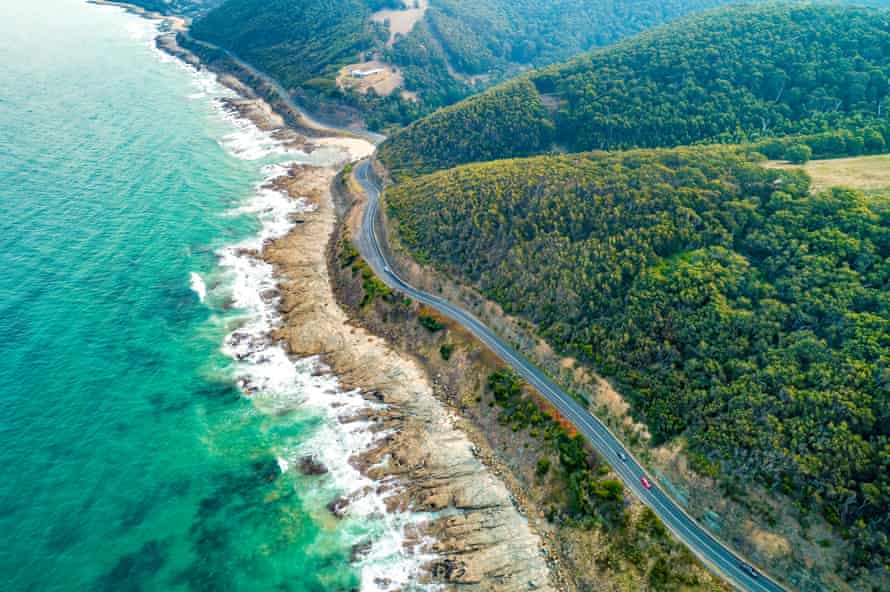
Aerial view of the Great Ocean Road just outside Lorne. Photograph: Tsvi Braverman/EyeEm/Getty Images
The entire drive can be tackled as a long day trip from Melbourne, though it pays to stay longer. Spend at least a few days riding waves and horses on Fairhaven Beach, chomping on fresh crayfish at Apollo Bay Fishermen’s Co-op and snooping around time-warped sites like Cape Otway Lightstation.
The Great Ocean Road weaves through Great Otway national park, where walking trails lead through temperate rainforest splashed by waterfalls. If you fancy a multi-day trek, ditch the wheels altogether and hit the 104km Great Ocean walk, the most intimate way to experience this fabled stretch of surf.
5. Walk alongside Australia’s highest sea cliffs on the Three Capes track
Tasmania/Palawa Country
Any list of epic Australian bushwalks is bound to contain the Three Capes track. Traversing a well-maintained path alongside the lofty sea cliffs in Tasman national park, this four-day, 48km trek kicks off after walkers are dropped by boat at the Denmans Cove trailhead.
The route links the cove with Cape Raoul, Cape Pillar and Cape Hauy before finishing on the sandy shores of Fortescue Bay. Scenery includes eucalypt forests, coastal heathland and ocean views for as far as the eye can see.
The Blade on Cape Pillar. Three Capes Lodge walk. Tasmania. Australia. 1 September 2018.
Accommodation is in ranger-supervised camps with architect-designed huts that are almost as good looking as the eye-popping coastal scenery.
You’ll walk up the slopes of Crescent Mountain and Mt Fortescue and down to Ellarwey Valley, seeing native flora and fauna aplenty. Daredevils can scale the well-named Blade Rock formation at Cape Pillar and plunge into the icy surf at Fortescue Bay. The track is described as being achievable for most ages and abilities, but some bushwalking experience is recommended.
WALK IT! Tasman national park is 100km south-east of Hobart. Boats collect walkers at Port Arthur. Daily walker numbers are capped, so book well ahead.
6. Explore the weird and wonderful rock formations of Bungle Bungles
Western Australia/Jaru And Gidja Country
The bizarre, ancient, beehive domes of the World Heritage-listed Purnululu national park will take your breath away. Known colloquially as the Bungle Bungles, these remote rocky ranges are the finest example of cone karst sandstone anywhere in the world.

The Bungle Bungles rock formations at Purnululu national park. Photograph: Alex Couto/Shutterstock
The distinctive rounded rock towers are made of sandstone and conglomerates moulded by rainfall over millions of years. To the local Gidja people, “purnululu” means sandstone, with Bungle Bungle possibly a corruption of “bundle bundle”, a common grass. The park is rich in fauna and flora, the walks take you through shady palm-fringed gorges, and the sunsets here are sublime. There’s refreshingly little infrastructure and it’s never crowded.
SEE IT! Access is via a rough, unsealed, flood-prone 4WD-only track from the Great Northern Hwy north of Halls Creek, or by air on a package tour from Kununurra or Warmun. For more information, visit www.parkstay.dpaw.wa.gov.au.
7. Enjoy the ultimate rainforest experience in Daintree national park
Queensland/Kuku Yalanji Country
The oldest tropical rainforest on the planet, the World Heritage-listed Daintree Rainforest is like a real life Jurassic Park, complete with living dinosaurs, from cassowaries to crocs.
South of the Daintree River, the Indigenous-run Mossman Gorge is the most accessible of the park’s two sections. Here an elevated boardwalk tracing the crystal-clear Mossman River connects to a scenic 2.4km rainforest circuit. Learn more about the Kuku Yalanji connections to this verdant oasis on a tour with Ngadiku Dreamtime Walks.
Some say you haven’t been to the Daintree until you’ve visited the Cape Tribulation section of the park north of the Daintree River, where rainforest meets the Great Barrier Reef. Allow several days to soak up this lush wilderness, dotted with rainforest boardwalks and idyllic croc-free swimming holes.
SEE IT! From Port Douglas it’s a 20-minute drive west to Mossman Gorge, and a 40-minute drive to the Daintree River Ferry.
8. Set sail for Kangaroo Island’s wilderness and wildlife
South Australia/Kartan Country
Kangaroo Island (KI) was scorched by bushfires in Australia’s “Black Summer” of 2019–20, but remains a veritable zoo of seals, birds, dolphins, echidnas and (of course) kangaroos. Island produce (wine, seafood, gin, beer), surf beaches and the kooky rock formations of Flinders Chase national park are also highlights.
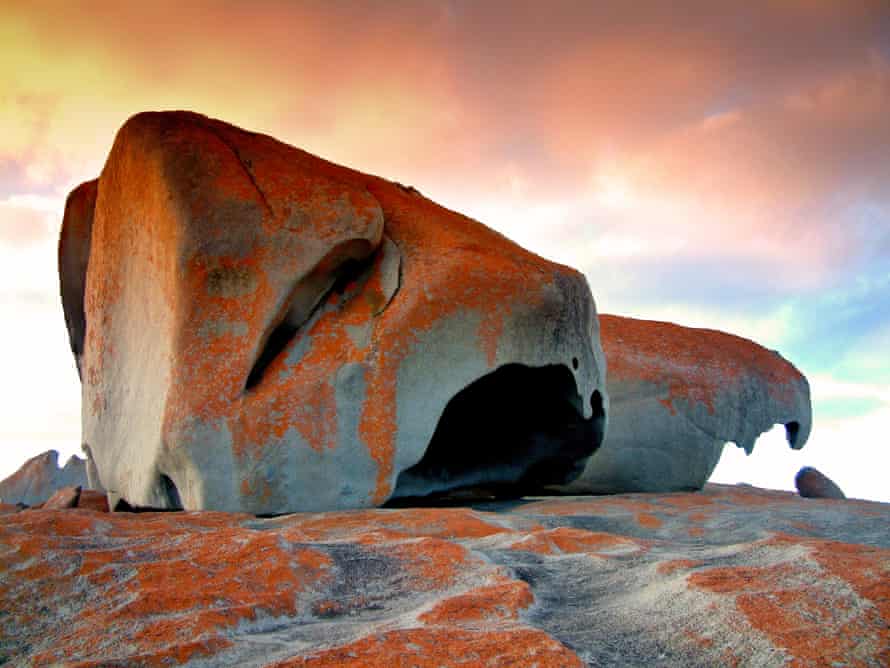
Remarkable Rocks on Kangaroo Island, South Australia. Photograph: Hypervision Creative/Shutterstock
These days, KI is rurally paced with a scattering of laid-back towns – the kind of place where kids ride bikes to school and farmers advertise for wives on noticeboards. The excellent five-day, 64km coastal Kangaroo Island Wilderness trail was ravaged by the fires, but trail reconstruction is under way: watch this space.
SEE IT! KI is big! You can’t see it all in a day. Bring your car on the ferry and explore over a weekend.
9. Marvel at the Milky Way in the Warrumbungle Dark Sky Park
New South Wales/Kamilaroi Country
The night sky unrolls around you each night in the Warrumbungle national park, Australia’s first and only Dark Sky Park. The 233 sq km park has been internationally recognised for its stunning views of the stars due to its high altitude, low humidity and carefully monitored light pollution.
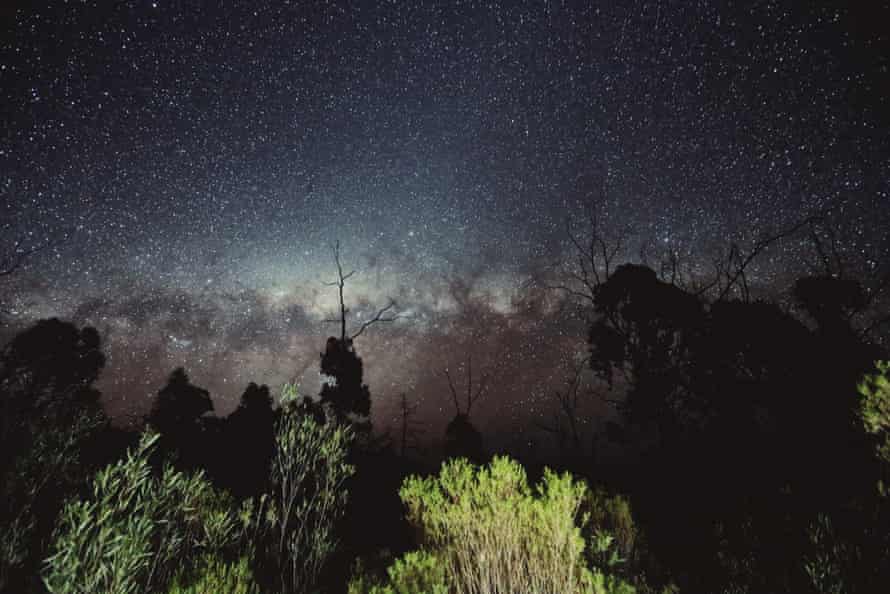
The Milky Way galaxy is visible high above the Warrumbungle national park in NSW. Photograph: Simon Bennett/Shutterstock
With four observatories to choose from, you can stargaze well into the night. Siding Springs Observatory is home to the largest optical telescope in Australia – with a mirror measuring 3.9m, the Anglo Australia telescope is capable of viewing quasars up to 12bn light years away.
The Warrumbungles still have plenty to offer once the sun rises. Avid bushwalkers are sure to enjoy the rugged volcanic landscape. The Breadknife and Grand High Tops walk will bring you close to the park’s most impressive formations. With over 190 bird species recorded within the park, birdwatchers should be sure to look out for emus, wedge-tailed eagles and the southern boobook owl.
For a more relaxing option, take a trip along the world’s largest Virtual Solar System Drive. The dome of the Siding Springs Observatory represents the sun, with scaled model planets stretching the whole 200km to Dubbo.
10. Light up your time in Sydney at the Vivid festival
New South Wales/Gadigal Country
During Vivid Sydney, video art and massive images are projected on to Sydney’s iconic architecture, with the sails of the Opera House, the arches of the Harbour Bridge and the sandstone buildings of the Rocks all transformed into leviathan canvases for a shimmering collage of spotlights, laser beams and electrified sky-high street art.
Journey on the harbour at night on the Manly Ferry for brilliant views, or join a chartered boat trip to take in the best of the glowing spectacle. Beyond the illuminations, music is also a stunning part of the Vivid experience, from big international artists to more intimate performances from the best of Australia’s emerging talent.
SEE IT! The festival is held annually for three weeks. The 2022 festival will take place from 27 May to 18 June.
11. Go wild on mainland Australia’s southernmost point, Wilsons Prom
Victoria/Brataualung Country
Hitting rock bottom is a good thing when it involves Wilsons Promontory. Occupying the southernmost point of mainland Australia, the 305 sq km national park claims some of Victoria’s most varied, magnificent natural landscapes: salt-white Squeaky Beach, the Saharan dunes of the Big Drift, the lushness of Lilly Pilly Gully.
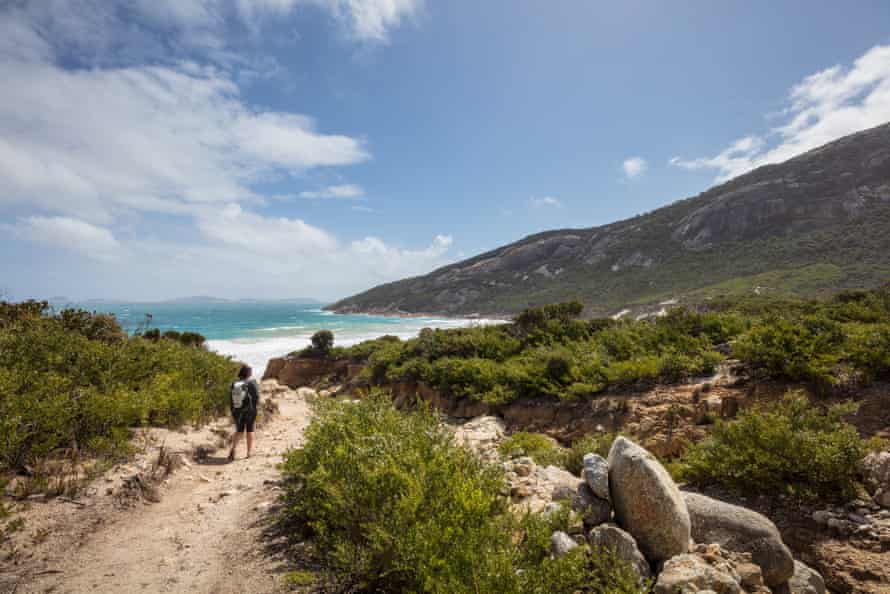
Hiking towards Little Oberon bay in Wilsons Promontory national park, Victoria, Australia. Photograph: Michael R Evans/Shutterstock
Walking tracks lead over ridges, across heathland and through headily scented bush alive with kangaroos, wombats, echidnas and iridescent birdlife. The Telegraph Saddle to Sealers Cove route (10.3km) is especially memorable, weaving through fern gullies and swampland to a forest-backed beach. It’s the first section of the challenging, multi-day Southern Circuit (59km), whose stops also include the monumental Oberon Bay.
A much quicker way to admire the bay’s sweep is from panoramic Mt Oberon, an easy 6.8km return hike from the Telegraph Saddle car park. Head up at sunset and pinch yourself.
SEE IT! Tidal River is the park’s hub, with visitor information, a general store and accommodation. Avoid school holiday periods and book accommodation in advance at www.parks.vic.gov.au.
12. Experience wildlife and Indigenous history in Kakadu
Northern Territory/Bininj/Mungguy Country
Kakadu ranks among the world’s great national parks. Its wetlands and escarpments shelter abundant wildlife and rock art that dates back 20,000 years. This is the land of the Bininj/Mungguy, whose presence brings soul and spirituality to any visit here.
Birdwatchers on the Bardedjilidji walk (Mon 27 Sep)
In just a few days you can cruise on billabongs bursting with wildlife, examine millennia-old rock paintings under the care of an Indigenous guide, swim in pools at the foot of tumbling waterfalls and hike through ancient sandstone escarpment country. Ubirr and Nourlangie are the main rock-art sites, Jim Jim has the best falls, Cahill’s Crossing is terrific for crocs, and Yellow Water (Ngurrungurrudjba) is great for birds and other wildlife. Kakadu is very popular and can become crowded – in the Dry at least. But this is a vast park, and with a little adventurous spirit you can easily get off the beaten track and be alone with nature.
13. Be wowed by white sands and crystalline water at Wineglass Bay
Tasmania/Palawa Country
The show-stealing centrepiece of Freycinet national park, curvaceous Wineglass Bay is Tasmania’s most famous beach for good reason. Its blindingly white sand and pink granite headlands splashed with flaming orange lichen are almost ludicrously photogenic, and a walk along its length to Hazards Beach is almost as rewarding as a swim in its gin-clear water.
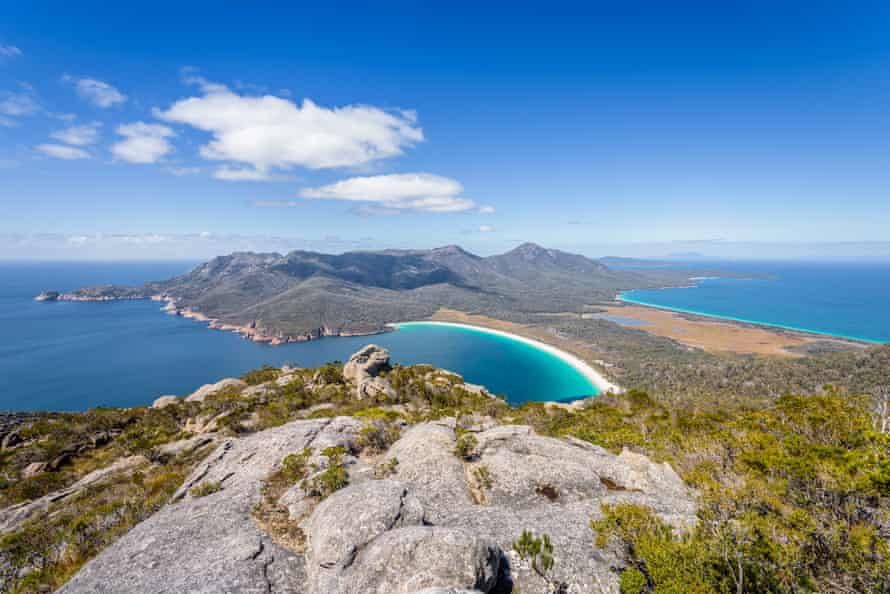
Wineglass Bay as seen from a rocky lookout at Freycinet national park. Photograph: Tom Jastram/Shutterstock
Views of the bay are best appreciated from the Wineglass Bay Lookout, a 90 minute walk from the national park’s walking track car park. From here, 1,000 steps lead down to the beach. Those who choose to stay longer and walk further can set off on the Freycinet Peninsula Circuit, a three-day, 30km trek around the peninsula from Hazards Beach south to Cooks Beach, then across the peninsula over a heathland plateau before descending to Wineglass Bay.
SEE IT! Wineglass Bay is 200km north-east of Hobart, via the Tasman Hwy (A3) and C302.
14. Hit the Grampians for an epic hike in Victoria’s Garden of Eden
Victoria/Jardwadjali and Djab wurrung Country
Hitchcock couldn’t have directed it better himself. A long, eerie crevasse; a sharp left turn, then – BAM! – Pinnacles Lookout and its knockout vista over ranges and plains.
Grampians Peaks Trail hike – hyperlapse video
Gotcha moments are thick on the ground when hiking Grampians national park, its sandstone peaks rising like petrified gods. While there are plenty of short strolls – the 4km Mt William (Duwul) Summit walk is breathtaking – the Grampians Peaks trail is the ultimate lace-up adventure.
A 160km long, 13-day odyssey, it spans the entire length of the Grampians (Gariwerd), from Mt Zero (Mura Mura) in the north to the culinary hamlet of Dunkeld in the south. Along it, precious landscapes unfurl, from woodlands and waterfalls to cooling fern valleys. Harboured within: red-tailed black cockatoos, endangered pincushion lilies and the haunting handprints and figures of Aboriginal rock art shelters like Ngamadjidj and Gulgurn Manja.
HIKE IT! See www.grampianspeakstrail.com.au for trail information. Foodies should book a night at Dunkeld’s Royal Mail Hotel.
15. Elevate your Sydney experience on the Bondi to Coogee clifftop walk
New South Wales/Gadigal Country
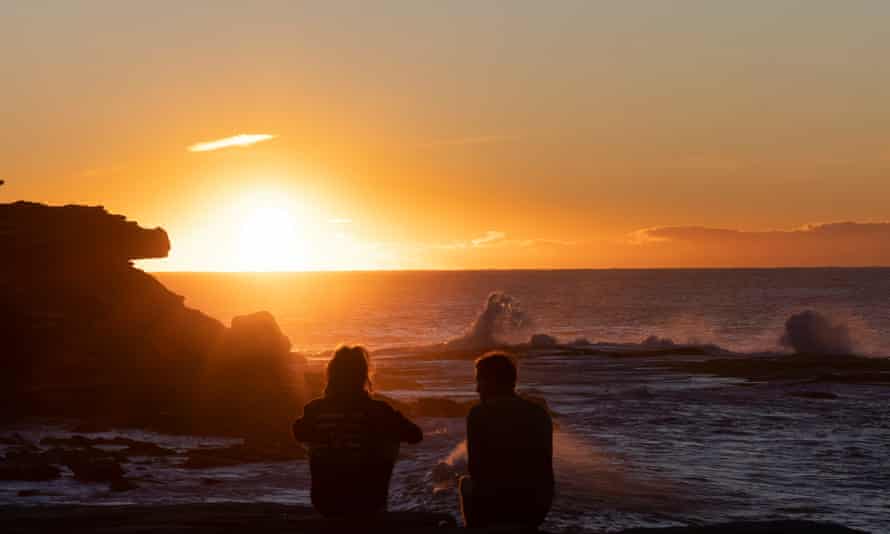
Clovelly Beach, Sydney, Australia. Photograph: Brook Mitchell/Getty Images
Say good morning to the perfect way to take in the best of Sydney’s coastal scenery. The simply sensational 6km Bondi to Coogee walk leads south from Bondi Beach along the clifftops via Tamarama, Bronte and Clovelly, interweaving panoramic views, patrolled beaches, sea baths, waterside parks and plaques recounting local Aboriginal stories. Pack your swimmers if the weather’s warm.
WALK IT! The trail begins at the southern end of Notts Ave near Bondi’s Hunter Park, and completes its view-friendly route near Dunningham Reserve at the northern end of Coogee.
16. Immerse yourself in the remarkable desert rocks of Kata Tjuta
Northern Territory/Anangu Country
There’s nowhere on earth quite like Kata Tjuta (formerly the Olgas), a striking group of domed rocks huddled together about 35km west of Uluru. The deep valleys and steep-sided gorges contain sites which are sacred to the local Anangu people.
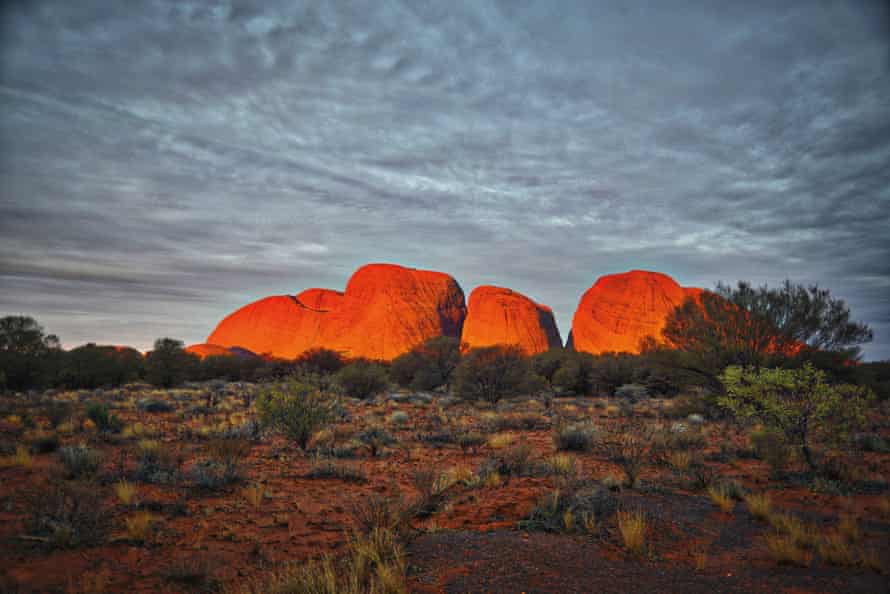
Kata Tjuta at sunset. Photograph: Rajeev Rajagopalan/Shutterstock
The tallest rock, Mt Olga (546m; 1,066m above sea level) is higher than Uluru. The Valley of the Winds loop, one of the most rewarding bushwalks in Australia’s Red Centre, winds through the gorges and past surreal domes in hues of the deepest red offset by the blue of the desert sky. Elsewhere, Walpa Gorge is especially beautiful in the afternoon, when sunlight floods the gorge. The views from the Sand Dune Lookout, off the road to Uluru, put everything in perspective.
17. Revere Port Campbell national park’s Apostles
Victoria/Girai wurrung Country
You couldn’t ask for a grander finale to the Great Ocean Road. As it shakes off the tortuousness of the Otway Ranges, forest turns to weather-beaten scrub, the sky bursts open and the route shoots west along a flat, narrow escarpment dropping away to terrifying ocean-pounded cliffs. This is Port Campbell national park, home to Victoria’s geological superstars, the Twelve Apostles.
Out of cold, savage waters they rise – monumental limestone stacks, abandoned by the retreating coastline. In truth, there are fewer than 12, but this fails to diminish their impact.
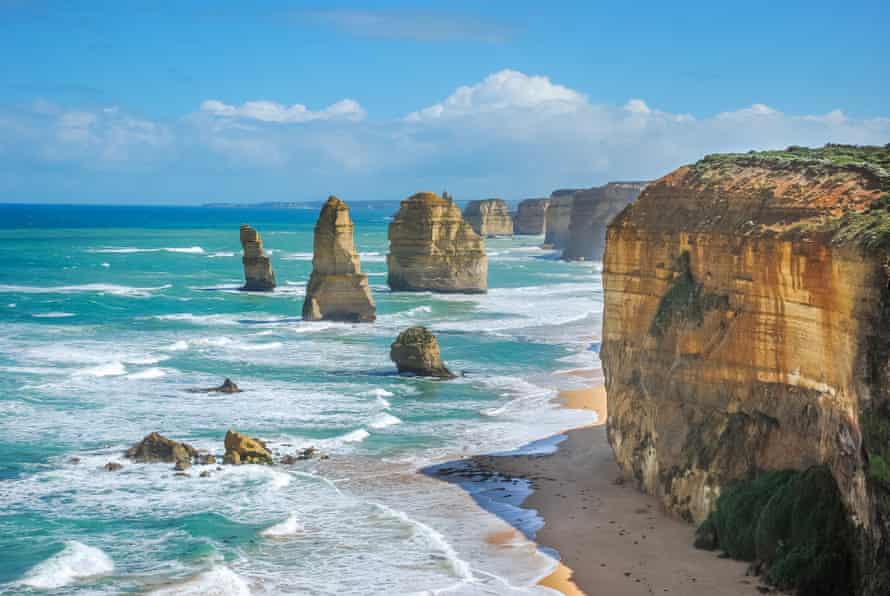
The Twelves Apostles at Port Campbell national park, Victoria, Australia. Photograph: Kamala Sakornmaneesup/Shutterstock
Less famous but no less spectacular are the Bay of Islands and London Bridge rock stacks, just west of sleepy Port Campbell township. Once a double-arched rock platform, London Bridge indeed fell down in 1990, leaving two terrified tourists marooned on the world’s newest island – they were eventually rescued by helicopter.
To the east of the Apostles, Loch Ard Gorge is where the Shipwreck Coast’s most famous and haunting tale unfolded, when two young survivors of the wrecked iron clipper Loch Ard made it to shore. From the clifftop, a path leads down to the cave where the pair took shelter.
The best time to visit is at sunset, not only for the optimal Instagram opportunities (and to beat the tour buses), but also to catch a glimpse of little penguins returning. Sightings vary, but generally the penguins arrive 30 minutes after sunset; don’t forget your binoculars!
18. Reconcile the laid-back splendour of Rottnest Island with its gruesome past
Western Australia/Noongar Country
With warm water, sunken wrecks, diverse marine life and 63 beaches, it’s little wonder people flock to “Rotto” to swim, fish, laze, dive, snorkel, surf and sea-kayak their cares away. And of course, no trip to Rottnest is complete without the obligatory selfie with the incredibly cute, furry and all-too-trusting quokka.
Highlights include “The Basin”, a family- friendly seawater pool, and the 20m Wadjemup Lighthouse on the island’s highpoint. Wadjemup is a Noongar word meaning “place across the water where the spirits are” – rather apt, given at least 373 unmarked graves hold the victims of a harsh and cruel prison for Aboriginal people operating during the 1800s.
19. Catch the Manly Ferry across one of the world’s greatest harbours
New South Wales/Guringai Country
The Manly Ferry is one of Sydney’s best bargains for visitors to the city. Take in Opera House and Harbour Bridge views before sliding past the ritzy suburbs of Point Piper and Rose Bay and exiting the rocky promontories of the Sydney Heads.
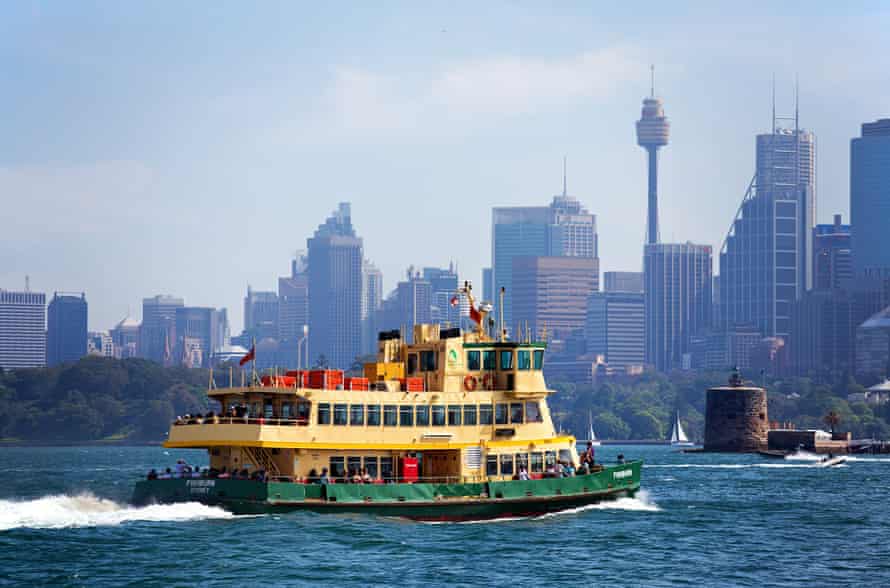
One of Sydney’s iconic ferries heads towards Circular Quay. Photograph: PomInOz/Shutterstock
Opposite Manly Wharf, refresh with a beer at the 4 Pines brewpub before strolling along the Corso to the surf, sand and Norfolk pine-lined esplanade of Sydney’s second-most famous beach. Pretty good for around $10.
CRUISE IT! The Manly Ferry departs from Wharf 3 at Circular Quay and takes around 20 minutes.
20. Dive into Queensland’s Museum of Underwater Art
Queensland/Bindal and Wulgurukaba Sea Country
As if the Great Barrier Reef wasn’t epic enough, you can now explore an underwater sculpture garden. The second instalment of the Townsville region’s Museum of Underwater Art, the Coral Greenhouse features 20 human figures performing conservation work in and around a submerged conservatory.
Designed by the renowned sculptor, Jason deCaires Taylor, in collaboration with Indigenous groups, the installation complements the Ocean SirTen sculpture.
DIVE IT! Dive tours to the Coral Greenhouse run from Townsville and Magnetic Island.
By: www.theguardian.com
